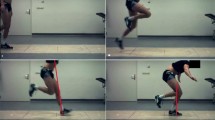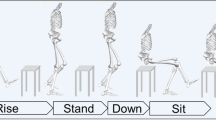Abstract
Purpose
To investigate the effect of different loads of knee extensor open kinetic chain resistance training on anterior knee laxity and function in the ACL-injured (ACLI) knee.
Methods
Fifty-eight ACLI subjects were randomised to one of three (12-week duration) training groups. The STAND group trained according to a standardised rehabilitation protocol. Subjects in the LOW and HIGH group trained as did the STAND group but with the addition of seated knee extensor open kinetic chain resistance training at loads of 2 sets of 20 repetition maximum (RM) and 20 sets of 2RM, respectively. Anterior knee laxity and measurements of physical and subjective function were performed at baseline, 6 and 12 weeks. Thirty-six subjects were tested at both baseline and 12 weeks (STAND n = 13, LOW n = 11, HIGH n = 12).
Results
The LOW group demonstrated a reduction in 133 N anterior knee laxity between baseline and 12 weeks testing when compared to the HIGH and the STAND groups (p = 0.009). Specifically, the trained-untrained knee laxity decreased an average of approximately 5 mm in the LOW group while remaining the same in the other two groups.
Conclusion
Twelve weeks of knee extensor open kinetic chain resistance training at loads of 2 sets of 20RM led to a reduction in anterior knee laxity in the ACLI knee. This reduction in laxity does not appear to offer any significant short-term functional advantages when compared to a standard rehabilitation protocol. These results indicate that knee laxity can be decreased with resistance training of the thigh muscles.
Level of evidence
Randomised controlled trial, Level II.


Similar content being viewed by others
References
Amis AA (2012) The functions of the fibre bundles of the anterior cruciate ligament in anterior drawer, rotational laxity and the pivot shift. Knee Surg Sports Traumatol Arthrosc 20:613–620
Barcellona MG, Morrissey MC, Milligan P, Amis AA (2013) The effect of hamstrings muscle activity on anterior knee laxity testing in the uninjured and anterior cruciate ligament-injured knee: a cross-sectional study. Knee Surg Sports Traumatol Arthrosc. doi:10.1007/s00167-013-2695-5
Beard DJ, Dodd CAF, Trundle HR, Simpson AHRW (1994) Proprioception enhancement for anterior cruciate ligament deficiency—a prospective randomized trial of 2 physiotherapy regimes. J Bone Joint Surg Br 76B:654–659
Binkley JM, Peat M (1986) The effects of immobilization on the ultrastructure and mechanical-properties of the medial collateral ligament of rats. Clin Orthop Relat Res 203:301–308
Burroughs P, Dahners LE (1990) The effect of enforced exercise on the healing of ligament injuries. Am J Sports Med 18:376–378
Chouteau J, Testa R, Viste A, Moyen B (2012) Knee rotational laxity and proprioceptive function 2 years after partial ACL reconstruction. Knee Surg Sports Traumatol Arthrosc 20:762–766
Clark NC (2001) Functional performance testing following knee ligament injury. Phys Ther Sport 2:91–105
Cram JR, Kasman GS, Holtz J (1998) Introduction to surface electromyography, 1st edn. Aspen Publishers, Gaithersburg
Daniel DM, Stone ML, Riehl BMMR (1982) A measurement of lower limb function: the one leg hop for distance. Am J Knee Surg 1:212–214
Daniel DM, Stone ML, Sachs R, Malcom L (1985) Instrumented measurement of anterior knee laxity in patients with acute anterior cruciate ligament disruption. Am J Sports Med 13:401–407
Field A (2005) Correlation. In: Wright DB (ed) Discovering statistics using SPSS. SAGE publications, London, pp 107–142
Fleming BC, Ohlen G, Renstrom PA, Peura GD, Beynnon BD, Badger GJ (2003) The effects of compressive load and knee joint torque on peak anterior cruciate ligament strains. Am J Sports Med 31:701–707
Fukuda TY, Fingerhut D, Moreira VC, Camarini PMF, Scodeller NF, Duarte A, Martinelli M, Bryk FF (2013) Open kinetic chain exercises in a restricted range of motion after anterior cruciate ligament reconstruction: a randomized controlled clinical trial. Am J Sports Med 41:788–794
Heijne A, Werner S (2007) Early versus late start of open kinetic chain quadriceps exercises after ACL reconstruction with patellar tendon or hamstring grafts: a prospective randomized outcome study. Knee Surg Sports Traumatol Arthrosc 15:402–414
Hooper DM, Morrissey MC, Drechsler WI, McDermott M, McAuliffe TB (2001) Validation of the hughston clinic subjective knee questionnaire using gait analysis. Med Sci Sports Exerc 33:1456–1462
Hsieh AH, Sah RL, Sung KLP (2002) Biomechanical regulation of type I collagen gene expression in ACLs in organ culture. J Orthop Res 20:325–331
Irrgang JJ, Anderson AF, Boland AL, Harner CD, Kurosaka M, Neyret P, Richmond JC, Shelborne KD (2001) Development and validation of the international knee documentation committee subjective knee form. Am J Sports Med 29:600–613
Keays SL, Bullock-Saxton JE, Newcombe P, Bullock MI (2006) The effectiveness of a pre-operative home-based physiotherapy programme for chronic anterior cruciate ligament deficiency.[erratum appears in Physiother Res Int. 2007 12(3):195]. Physiother Res Int 11:204–218
Kjaer M (2004) Role of extracellular matrix in adaptation of tendon and skeletal muscle to mechanical loading. Physiol Rev 84:649–698
Langberg H, Skovgaard D, Petersen LJ, Bulow J, Kjaer M (1999) Type I collagen synthesis and degradation in peritendinous tissue after exercise determined by microdialysis in humans. J Physiol London 521:299–306
Langberg H, Skovgaard D, Asp S, Kjaer M (2000) Time pattern of exercise-induced changes in type I collagen turnover after prolonged endurance exercise in humans. Calcif Tissue Int 67:41–44
Laros GS, Tipton CM, Cooper RR (1971) Influence of physical activity on ligament insertions in knees of dogs. J Bone Joint Surg Am Vol A 53:275–286
Moksnes H, Snyder-Mackler L, Riseberg MA (2008) Individuals with an anterior cruciate ligament-deficient knee classified as noncopers may be candidates for nonsurgical rehabilitation. J Orthop Sports Phys Ther 38:586–595
Morrissey MC, Hudson ZL, Drechsler WI, Coutts FJ, Knight PR, King JB (2000) Effects of open versus closed kinetic chain training on knee laxity in the early period after anterior cruciate ligament reconstruction. Knee Surg Sports Traumatol Arthrosc 8:343–348
Morrissey MC, Perry MC, King JB (2009) Is knee laxity change after ACL injury and surgery related to open kinetic chain knee extensor training load? Am J Phys Med Rehabil 88(369):375
Myer GD, Ford KR, Paterno MV, Nick TG, Hewett TE (2008) The effects of generalized joint laxity on risk of anterior cruciate ligament injury in young female athletes. Am J Sports Med 36:1073–1080
Norouzi S, Esfandiarpour F, Shakourirad A, Salehi R, Akbar M, Farahmand F (2013) Rehabilitation after ACL Injury: a fluoroscopic study on the effects of type of exercise on the knee sagittal plane arthrokinematics. Biomed Res Int 2013:7
Perry MC, Morrissey MC, Morrissey D, Knight PR, McAuliffe TB, King JB (2005) Knee extensors kinetic chain training in anterior cruciate ligament deficiency. Knee Surg Sports Traumatol Arthrosc 13:638–648
Perry MC, Morrissey MC, King JB, Morrissey D, Earnshaw P (2005) Effects of closed versus open kinetic chain knee extensor resistance training on knee laxity and leg function in patients during the 8-to 14-week post-operative period after anterior cruciate ligament reconstruction. Knee Surg Sports Traumatol Arthrosc 13:357–369
Perry MC, Morrissey MC, Jones JS, Paton B, McAuliffe TB, King JB, Thomas P (2005) Number of repetitions to maximum in hop tests in patients with anterior cruciate ligament injury. Int J Sports Med 26:688–692
Ramesh R, Von Arx O, Azzopardi T, Schranz PJ (2005) The risk of anterior cruciate ligament rupture with generalised joint laxity. J Bone Joint Surg Br 87-B:800–803
Reid A, Birmingham TB, Stratford PW, Alcock GK, Giffin JR (2007) Hop testing provides a reliable and valid outcome measure during rehabilitation after anterior cruciate ligament reconstruction. Phys Ther 87:337–349
Tagesson S, Oberg B, Good L, Kvist J (2008) A comprehensive rehabilitation program with quadriceps strengthening in closed versus open kinetic chain exercise in patients with anterior cruciate ligament deficiency: a randomized clinical trial evaluating dynamic tibial translation and muscle function. Am J Sports Med 36:298–307
Tegner Y, Lysholm J (1985) Rating systems in the evaluation of knee ligament injuries. [Report]. Clin Orthop Relat Res 198:42–49
Tipton CM, Vailas AC, Matthes RD (1986) Experimental studies on the influences of physical-activity on ligaments, tendons and joints—a brief review. Acta Med Scand 711:157–168
Uhorchak JM, Scoville CR, Williams GN, Arciero RA, St PP, Taylor DC (2003) Risk factors associated with noncontact injury of the anterior cruciate ligament: a prospective four-year evaluation of 859 West Point cadets. Am J Sports Med 31:831–842
Vauhnik R, Morrissey M, Rutherford O, Turk Z, Pilih I, Pohar M (2008) Knee anterior laxity: a risk factor for traumatic knee injury among sportswomen? Knee Surg Sports Traumatol Arthrosc 16:823–833
Ware JE, Kosinski M, Bjorner JB, Turner-Bowker DM, Gandek B, Maruish ME (2010) User’s manual for the SF-36v2 health survey, 2nd edn. QualityMetric Inc, Lincoln
Woo SLY, Abramowitch SD, Kilger R, Liang R (2006) Biomechanics of knee ligaments: injury, healing, and repair (Review). J Biomech 39:1–20
Woo SLY, Amiel D, Akeson WH, Kuei SC, Tipton CM (1979) Effect of long-term exercise on ligaments, tendons and bones of swine. Med Sci Sports Exerc 11:105
Woo SLY, Gomez MA, Woo YK, Akeson WH (1982) Mechanical-properties of tendons and ligaments. 2. the relationships of immobilization and exercise on tissue remodeling. Biorheology 19:397–408
Author information
Authors and Affiliations
Corresponding author
Rights and permissions
About this article
Cite this article
Barcellona, M.G., Morrissey, M.C., Milligan, P. et al. The effect of knee extensor open kinetic chain resistance training in the ACL-injured knee. Knee Surg Sports Traumatol Arthrosc 23, 3168–3177 (2015). https://doi.org/10.1007/s00167-014-3110-6
Received:
Accepted:
Published:
Issue Date:
DOI: https://doi.org/10.1007/s00167-014-3110-6




